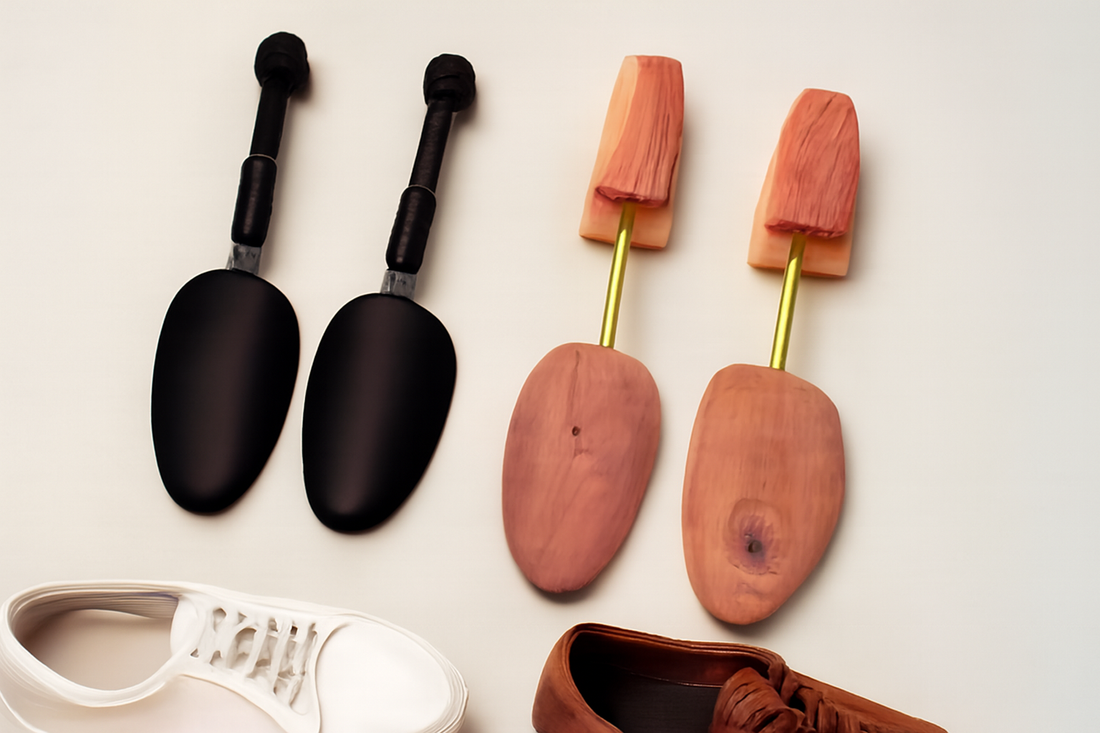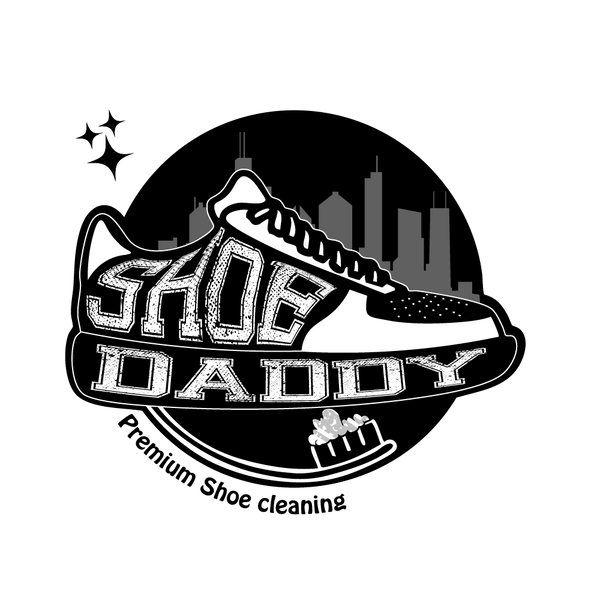
Why You Need Shoe Trees: The Ultimate Sneaker Care Tool
Share
You just bought a fresh pair of sneakers, maybe the latest Jordans, a classic pair of Air Force 1s, or a sleek set of leather trainers. You unbox them, admire them, and can't wait to show them off. But have you thought about what happens after the first, fifth, or fiftieth time it's worn? How do you keep them looking as good and fresh as the day you bought them? The answer might be simpler and more effective than you think: a humble shoe tree.
Many people think that shoe trees are an old-fashioned accessory for fancy dress shoes, but they are, without a doubt, the ultimate sneaker care tool. If you've invested in your footwear collection, now it’s time to invest in its longevity. This guide will walk you through everything you need to know about shoe trees, what a shoe tree is, what it does and why shoe trees for sneakers are no longer a luxury, but a necessity.
What Exactly Are Shoe Trees and How Do They Work?
Let's start with the basics. What is a shoe tree? In simple terms, it's a device shaped like a foot that you place inside your shoes when you're not wearing them. Its primary job is to help the shoe maintain its original shape, but its benefits go far beyond that.
Think about what your sneakers go through in a single day. They endure constant twists and turns, pressure from your feet and exposure to sweat and moisture. When you take them off, the materials, whichever they be, are warm and damp. As they cool and dry, they contract and shrink, which is how deep creases and toe box collapse happen.
A shoe tree works by providing a solid support for the shoe to rest on as it dries. This gentle, consistent pressure smooths out the lining and counteracts crease formation. It keeps the toe box perfectly rounded and the heel counter supported, preventing your sneakers from looking old and worn out before their time. Doesn't preserving that "fresh out of the box" look sound amazing?
Moisture: The Unseen Enemy and Your Sneaker’s Worst Nightmare
One of the most significant yet overlooked benefits of using shoe trees is effective moisture absorption. Your feet have over 250,000 sweat glands, and they can produce up to a pint of sweat on a hot day. Where does all that moisture go? Straight into the lining and insole of your sneakers.
This trapped moisture is a triple threat:
- It breaks down materials: Leather becomes brittle, glues can weaken, and fabrics can degrade over time when constantly exposed to the acids in sweat.
- It causes odors: The warm, damp environment inside a shoe is a perfect breeding ground for bacteria and fungi, which are the root cause of unpleasant foot odor.
- It ruins the shape: When damp materials dry without support, they shrink and warp, leading to unsightly wrinkles and a collapsed structure.
So, how does a quality shoe tree combat all this? The best ones are made from unfinished wood, particularly cedar. Cedar is naturally porous and acts like a sponge, drawing moisture out of the shoe's interior. As it absorbs the dampness, it also releases its own natural aromatic compounds, which act as a powerful, built-in deodorizer. It doesn’t just mask the smell; it tackles the problem at its source.
Are All Shoe Trees Created Equal? Choosing the Best Shoe Tree
Now that you're convinced you need them, you might be wondering, "What is the best shoe tree for my collection?" Not all are made the same, and the right choice depends on your needs and the type of shoes you own.
Wooden vs. Plastic: Is There a Clear Winner?
Plastic Shoe Trees: These are typically lightweight, cheap, and great for travel. They will help maintain the shape of your sneakers to a degree, but they offer zero moisture absorption or deodorizing benefits. If your primary goal is to prevent your suitcase from crushing your shoes, they can work in a pinch. However, for everyday care, you need to innovate. Put the plastic shoe trees in your shoes and place them in a warm, dry environment. This will help dry out the stubborn moisture inside the shoe, reducing the foul odor coming from it.
Wooden Shoe Trees (Cedar): This is the gold standard for ultimate sneaker care. It helps with:
- Superior Moisture Control: It naturally wicks away sweat, preserving the leather, fabric, and adhesives in your shoes.
- Natural Deodorizer: The aromatic oils in cedar neutralize odors, keeping your sneakers fresh.
- Durability: A quality pair of cedar shoe trees can last a long time, making them a long-term investment.
What About Adjustable Shoe Trees?
Flexibility is key, especially when you have a diverse collection of sneakers. This is where adjustable shoe trees shine. The front toe piece is often split, allowing it to expand and fill the toe box, while the heel is fully contoured to support the back of the shoe. This design provides gentle, even pressure from heel to toe, which is crucial for smoothing out creases across the entire upper. A proper fit is essential because a shoe tree that's too small won't do its job, and one that's too large can stretch and damage your sneakers.
Why Shoe Trees for Sneakers Are a Modern Essential
The sneaker game has changed. Shoes are no longer just functional items; they are high-value assets, fashion statements, and collector's items. With pairs like Off-Whites, Travis Scotts, and classic Jordans fetching hundreds or even thousands of dollars, doesn't it make sense to protect them? Using a dedicated shoe tree for sneakers is one of the most cost-effective ways to protect your investment.
Let's break down the specific benefits for different types of popular sneakers.
Protecting Your High-Tops: The Jordan Shoe Tree Advantage
Think about your favorite pair of Air Jordans, particularly models like the AJ1, AJ3, or AJ4. What's one of the first signs of wear? Creases across the toe box. The dreaded "toe crease" can instantly make a crisp pair of Jordans look tired and beaten.
A good Jordan shoe tree is designed to combat this. By sliding a pair of cedar shoe trees into your Jordans as soon as you take them off, you apply gentle pressure that pushes those creases out while the leather is still warm and pliable. The full, contoured heel also helps the iconic silhouette of a Jordan 1 maintain its upright structure, preventing the ankle collar from slumping. For any serious Jordan collector, using shoe trees is non-negotiable.
Finding the Best Shoe Trees for Sneakers: A Buyer's Guide
Feeling ready to make a purchase? Finding the best shoe trees for sneakers involves looking for a few key features. Here’s a checklist to guide you:
- Material is King: Always opt for 100% natural, unfinished cedar wood. Avoid varnished or lacquered trees, as the coating seals the wood and prevents it from absorbing moisture and releasing its scent.
- Look for an Adjustable Design: A spring-loaded length and a split toe provide the best, most versatile fit. This allows the tree to adapt to the unique shape of your sneakers without causing damage.
- Check the Heel Shape: A fully shaped, contoured heel is better than a simple knob. It provides more surface area to support the back of the shoe and helps maintain its structure.
- Get the Right Size: Most shoe trees come in size ranges (S, M, L, XL) that correspond to shoe sizes. Check the manufacturer's sizing chart. If you're between sizes, it's generally better to size down to avoid overstretching your shoes.
- Consider the Brand: While you don't need a designer brand, stick with reputable companies that specialize in shoe care. They understand the nuances of proper design and use quality materials.
How to Use Shoe Trees Correctly: A Step-by-Step Guide
Using a shoe tree is incredibly simple, but there are a few best practices to maximize its effectiveness.
- Use Them Immediately: The best time to insert shoe trees is right after you take your sneakers off. This is when the material is most pliable and the moisture content is highest.
- Insert with Care: Compress the spring-loaded tree and slide the toe part all the way to the front of the shoe. Then, let the heel part expand and settle into the back. It should be a snug fit, not a forced one.
- Let Them Work Their Magic: Leave the shoe trees in your sneakers for at least 24 hours. This gives the cedar wood enough time to fully absorb the moisture and for the shoe's material to cool and set in the correct shape.
- Rotate Your Sneakers: If possible, avoid wearing the same pair of sneakers two days in a row. Giving them a full day's rest with shoe trees inside will extend their lifespan and keep them looking their best.
- Maintain Your Shoe Trees: About once a year, if you notice the cedar scent fading, you can lightly sand the surface with fine-grit sandpaper. This will open up the wood's pores and release a fresh wave of aromatic oils, or change your plastic shoe trees once you feel they have done their time.
Shoe Tree: An Investment, Not an Expense
By preventing creases, eliminating odor, and maintaining shape, shoe trees keep your sneakers in rotation for longer. You'll replace them less often, and if you're in the resale market, shoes kept in pristine condition with shoe trees are sold at a much higher price. It’s one of the smartest and most affordable ways to protect your footwear portfolio.
Why wait until your favorite sneakers are creased, smelly, and misshapen? Start protecting them from day one and you'll thank yourself and us months and years down the line when your shoes still look and feel fantastic. It’s time to stop seeing shoe trees as an optional extra and start seeing them for what they are: the single most important tool in your sneaker care arsenal.
Frequently Asked Questions (FAQ’s)
1. What is a shoe tree and why should I use one for my sneakers?
A shoe tree is a shaped support inserted into your shoes when they are not in use. It maintains their shape, reduces creases, and absorbs moisture, making it essential for keeping sneakers looking fresh.
2. Are shoe trees for sneakers different from those used in dress shoes?
While the core function is the same, shoe trees for sneakers are often made to fit sportier shapes and may use lighter materials or have unique features to accommodate modern sneaker designs.
3. How do adjustable shoe trees work, and should I choose them?
Adjustable shoe trees can expand or contract for a more precise fit in different shoe sizes and types. They’re great for those with a varied sneaker collection.
4. What are the best shoe trees for sneakers?
It primarily depends on your objective. Plastic shoe trees are lightweight and best for travel and minimal use; however, the best shoe trees for sneakers are usually made from natural, unfinished cedar with an adjustable design to fit various sizes. Cedar absorbs moisture and odors, helping protect fabric and leather sneakers.
5. Can shoe trees help with odor control in sneakers?
Yes! Cedar shoe trees are especially effective, as they wick away moisture and have natural deodorizing properties that combat unpleasant smells in your sneakers.
6. How often should I use shoe trees in my sneakers?
For best results, insert shoe trees every time you take your sneakers off, especially after active wear. This maintains shape and prolongs their life.
7. Do I need a shoe tree for every pair of sneakers?
While not strictly necessary, having a shoe tree for each frequently worn pair is ideal for consistent care and preservation.
8. Will using shoe trees stretch out my sneakers?
A properly-sized shoe tree will not stretch your sneakers; it will simply maintain their original shape. Avoid shoe trees that are too large or forceful for your shoes.
9. Can I use plastic shoe trees instead of wooden ones for my sneakers?
Plastic shoe trees help maintain shape but don’t absorb moisture or odors. Wooden shoe trees, especially cedar, are more effective for long-term sneaker care.
10. Can shoe trees prevent creases in sneaker toe boxes?
Absolutely. Shoe trees minimize and may reverse creasing in the toe box area by supporting the material while it dries and rests.
11. How do I choose the right size shoe tree for my sneakers?
Check the manufacturer’s size chart; most shoe trees come in ranges. Adjustable shoe trees offer flexibility and a custom fit for different sneakers.
12. Are shoe trees worth the investment for average sneaker wearers?
Definitely. Whether you’re a collector or just want your favorite kicks to look new longer, shoe trees are a small investment with big results.
13. Where can I find the best shoe trees for sneakers?
Shop reputable shoe care retailers or trusted online stores like www.shoedaddyusa.com

